Since my first post, I've had a few people express concern over the size of the color coded food containers. Yes, they LOOK small, but trust me, they hold A LOT more food than you'd think! In fact, everyone in my 21-Day Fix accountability group has commented at some point that they're amazed at the amount of food they're able to eat on this plan, and still lose weight! That's because they're fueling their body with nutrient dense foods.
|
As promised, here is my week 2 update for the 21-Day Fix! First of all, I seriously can't believe how fast this is going. Two weeks already! Since my first post, I've had a few people express concern over the size of the color coded food containers. Yes, they LOOK small, but trust me, they hold A LOT more food than you'd think! In fact, everyone in my 21-Day Fix accountability group has commented at some point that they're amazed at the amount of food they're able to eat on this plan, and still lose weight! That's because they're fueling their body with nutrient dense foods. This week I bumped myself up the the next level of calories, which allows me a couple extra containers. I've also been experimenting a lot more with my food. I'm still doing a lot of smoothies and stir fry's, but I've also been adding other things like sushi, sweet potato and red pepper bisque, kale, quinoa and avocado salad and brownie bites. (Yes! Brownie bites!) Now that I'm in the swing of things, food prep has become second nature and I'm able to adapt some of my favorite recipes to fit the plan. This week was also the first week I used one of my "Zings", or substitutions. You're allowed three Zings a week, and they include wine, chocolate and there are even a few cookie recipes you can use. I was pretty boring and I used mine for soy milk in my decaf coffee. It's actually been an interesting two weeks, I haven't even wanted to cheat on the meal plan and I haven't had any cravings at all (which is TOTALLY not like me!) It's also been super easy to follow the meal plan using printable charts that can be found here. This week also came with some pretty EXCITING NEWS for VEGANS! This week we got the green light to add beans, lentils and quinoa to the red foods category! This news came at the perfect time, too. After two weeks of protein powders and tofu I feel like I've swallowed a brick! I'm also pretty happy I get to add some more fiber back into my diet. So this is what the updated vegan 21-Day Fix food list looks like! I'm getting much better with the workouts, too. I'm getting the moves down, I'm not as sore, and I'm already seeing RESULTS!!! I can honestly say that I have never in my life worked my abs as much as I have this past week, which is good news because I'm heading on a Beachbody cruise in just four short weeks. After two weeks of doing the 21-Day Fix, I'm down 2.8 lbs, putting my total weight loss since Christmas at 9.4 lbs! So now that I'm entering into my final week, a few things are going to change. First, I'm going to add in the Plyo Fix bonus workout. This is a free workout you get when you order through your coach (me!) and can be added in any time you feel like doing a little extra cardio, or you can use it to replace Cardio Fix, which is what I'll be doing at least one of the days. Second, I'll be switching over to the 3-Day Quick Fix meal plan for my final three days, Thursday, Friday and Saturday. This is a 3-day bikini prep meal plan that is optional for your last 3 days of the 21-Day Fix. It is a typical competition meat and veggies diet, so I'll be pulling out the tofu and protein powders again for those three days. This week also came with some other great news! After the 21-Day Fix SOLD OUT only 3 days after being released, back orders started shipping this past weekend. If you'd like to learn how to FUEL YOUR BODY properly for optimal weight loss and energy, reserve your spot for my next facebook accountability group by messaging me on facebook or filling out the form found here and I will get back to you shortly!
43 Comments
Fall is in the air and that means one thing... FIGS are in season! Figs are a power packed little fruit, containing fiber, calcium & iron, Vitamins A, E & K and antioxidants and they also help lower blood sugar. Today's Meat Free Monday recipe was inspired and adapted from the cookbook The Vegan Table by Colleen Patrick-Goudreau. We paired her Braised Figs with Arugula salad with some simple portabello mushroom caps.  Braised Figs with Arugula salad 1 Tbsp non-dairy butter (such as Earth Balance) 1 tsp granulated sugar 10-12 figs, halved, stems removed 4-5 Tbsp balsamic vinegar 1 bunch baby arugula (we actually each get our own container!) 1 Tbsp olive oil juice from 1 lemon salt & pepper In large saute pan, melt butter and sugar. Place figs face down in pan and cook for 3-5 min. over med-high heat. Remove from heat and pace figs on plate, face up. (Depending on your dietary concerns, the non-dairy butter and sugar could be omitted,) In the same skillet, heat balsamic vinegar until bubbly, then reduce heat and simmer 4-5 min. until vinegar is reduced by half. Remove from heat. In a bowl, toss arugula with olive oil and lemon juice to coat. Sprinkle with salt and pepper. Heap arugula on plate, arrange figs over top and drizzle with the balsamic reduction. Portabello Mushroom Caps 6 small or 3 large portabello mushroom caps Brags liquid amino acids onion powder garlic powder Remove stems and underside of mushrooms. Cook all ingredients in a skillet over med-high heat about 6-10 min, flipping the mushroom caps half way through cooking. Large mushroom caps can be left whole, or sliced before cooking. If you try this recipe be sure to comment below and let us know what you thought! 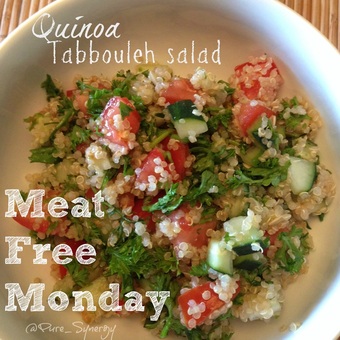 Chances are you've heard of both quinoa and tabbouleh before, but aren't really sure what either one is. Quinoa has gained popularity over the years, and was even featured in a recent NFL beer commercial. It's a complete protein and is a good source of fiber, phosphorus, magnesium and iron. It's also gluten-free. Tabbouleh is a middle eastern salad typically made with bulgur wheat. By using quinoa in this tabbouleh instead of bulgur, it's suitable for people who are eating gluten-free. 1 cup dry quinoa, cooked according to package directions 1 cucumber, diced 3 roma tomatoes, diced green onions, chopped 1 bunch parsley, chopped handful fresh mint, chopped juice from one lemon sea salt Cook quinoa according to package directions. Let cool, mix in all other ingredients. Variations: garlic, cinnamon, shredded carrots, olives Serve in lettuce wraps. Makes 4 servings. Per serving: Calories: 209 Total Fat: 2.8 g Cholesterol: 0 mg Total Carbs: 36.1 g Dietary Fiber: 1.8 g Protein: 8 g Kale! This powerful leafy green superfood is quickly finding it's way into the homes of many people who are trying to get healthy. And for good reason! It's packed with vitamins K, A and C, has more calcium than milk, more iron than beef, is loaded with antioxidants and is anti-inflammatory. If you haven't tried kale yet, what are you waiting for!? :) Scott and I both put a big handful of kale in our green smoothies every morning, but there are a few other ways to eat this super charged plant. One of those ways is kale chips! Kale chips are great for people like me, who like to have food to pick at. I can get stuck mindlessly eating a bag of chips, but kale chips help erase the guilt! And they're super easy to make. You can use either your oven or a dehydrator. I like to use my dehydrator because I can control the temperature better, and keep the temp low enough so that they're still considered a raw food. By keeping them raw, more of the enzymes and nutrients are still intact. You can play around with the different spices as you go, but this recipe for kale chips is one of my favorites so far. Today I started with a BIG bag of kale that I got from BJ's Wholesale. I know, not organic, but the convenience factor won me over because they were already broken into small pieces. If you do decide to use fresh kale, you'll want to make sure you wash it really well, remove the stems, and break it into small pieces. If you're using kale from a bag, be sure to go through and remove the stems.
Once you've washed your kale, removed the stems and broken it into pieces, put it in a large bowl and add the oil and agave. I usually use olive oil, but today the only oil I had in my house was coconut oil and it worked just as well, I just had to warm it a bit first so it was a softer consistency. Mix together one Tbsp oil to one to two Tbsp's agave, depending on how sweet you want them. Massage the kale with the oil and agave in a large bowl, making sure the mixture is coating all the kale. (Massaging kale is also great when using kale for salads, too!) Sprinkle with sea salt and cayenne. Be careful with the cayenne, the kale will shrink when it dehydrates, the cayenne will NOT!
Once you have all the kale coated it's ready to go into the dehydrator. Spread out the kale evenly, then adjust your temperature so it's below 118 F. This will ensure that they're still raw. I put my temperature gauge somewhere between the first two settings. It will take a few hours for them to dry out. You'll be able to tell when they're ready because they will be crispy and won't be flexible. I just use a cheap dehydrator that I got years ago. It works well enough. Sometimes the food on the top shelves gets done a bit sooner than the bottom shelves, so I just remove the top shelves once they're done and keep the bottom ones on until they're ready. Once they're done they're ready to eat! Store them in an airtight container in the fridge. Just before I eat them I sprinkle them with nutritional yeast.
Rhubarb is a great source of calcium, vitamin K, lutein (which helps with your skin and eyes) and antioxidants, and also helps lower your cholesterol. We have so much of it growing in our backyard, and with all those health benefits you'd think we'd eat it all the time, but we really don't. Why? There are so many great rhubarb recipes out there, but unfortunately, because rhubarb is so sour, they all contain a ton of added sugar. Until now. :) This weekend it was hot and sunny out. Perfect weather for me to make my homemade, sugar-free lemonade (which I should really post a recipe for!) and then it hit me... I could juice rhubarb! So I grabbed a couple stalks and headed to the kitchen! I juiced approximately two BIG stalks and ended up with a full cup of rhubarb juice. (For those of you who juice regularly, you know that's a lot of juice!) Since rhubarb is almost all water, it had a very high juice yield, but because of the fiber in the stalks, it really clogged up my juicer, almost like wheatgrass does. I used my Kuvings masticating juicer. I'd be interested to see how it juices in a centrifugal juicer. Then I juiced some fresh stevia leaves, fresh mint leaves, and a pint of strawberries, leaving the tops on. This juiced much thicker than the rhubarb and almost pulpy. After that I just added it to a bunch of ice and topped it off with club soda, but you could also use water (which is what I do for my lemonade). And that's it! It was so nice and refreshing. You could also play around with it and add frozen blueberries, peaches or other fruit, and replace the fresh Stevia with a different sweetener, or omit it all together.
If you make this, let me know in the comments below how you liked it and if you made any adjustments to the recipe! Q: Are you eating real food?
A: Yes! This is not a cleanse where you are only drinking cayenne pepper and maple syrup and it's not a juice fast. You will be eating a whole-food, mostly plant-based, clean eating diet. The recipes in the Ultimate Reset are simple, yet delicious! Don't believe me? Just check out these actual pictures I took of the food I ate when I did the Reset! Q: Will I be hungry while doing the Reset? A: The portions are surprisingly larger than than you would expect for a cleanse, but you are not leaving each meal feeling full or stuffed. This may be a new feeling to you if you're used to eating to maximum capacity. For me, it made me realize what true hunger felt like. It also made me realize how often I eat without thought and how much I ate when I was bored, tired and "just because". I physically had enough food, but mentally it took some getting used to. Q: Is the food expensive? A: Yes and No. The first week a good portion of the shopping list is made up of staples; olive, sesame and coconut oils, Bragg's liquid amino acids, miso, three different vinegars, quinoa, millet, rice cereal, spices, nuts, seeds, etc. These are things that you need for the Reset, but that will also last you much longer than the 21 days and become staples in your cupboard. I was fortunate enough to have a few of them on hand already, but if you don't have any to start they can quickly add up. After the first week, the shopping lists are mostly fresh fruit and vegetables, so it's not as bad. Don't forget, during the Reset you're also not going to be going out to dinner, picking up fast food for lunch, stopping for happy hour drinks, or buying your usual coffee or latte in the mornings. Those are things that add up quickly so you may find you are actually saving money doing the Reset. But seriously, even if it is more expensive, it's for your HEALTH so it's TOTALLY worth it! Q: What kind of results can I expect? A: Everyone's results are going to be different, but common results of the Ultimate Reset are weight loss, increased energy, decreased cholesterol and blood pressure, decrease in cellulite, better digestion, improved sleep patterns, improved allergies, clearer skin, better mental clarity, more stable blood sugar levels, stronger immune system and decreased inflammation and arthritis. The Ultimate Reset will soon be cited in a peer-reviewed medical journal for it's efficacy in addressing cholesterol and Type 2 diabetes. Here are my personal results from the Ultimate Reset. Q: Can I have caffeine or smoke while doing the Ultimate Reset? A: No. The point of the Reset is to rid your body of toxins, so ingesting toxins while doing the Reset would be counterproductive. During the Reset you are aiming to bring your body back to an alkaline state and coffee is very acidic. You may experience a headache for the first few days if you are used to drinking coffee, but by the end of the 21 days you will find that you no longer need the caffeine boost and that your energy levels are actually higher without it. Q: Can I workout while on the Reset? A: No. While on the Reset you want to give your body a break to let it rest and repair itself from the inside out. Exercise causes a break down of muscles and a build up of lactic acid. If you workout while on the Reset your body will be spending it's time repairing tissue and flushing out lactic acid instead of healing and repairing itself. Q: I'm already vegan, but I see the first week of the Reset has meat and dairy. Can I make substitutions? A: Yes! Once you purchase the Ultimate Reset you can log on to www.ultimatereset.com and there you will find the vegan meal plan for week 1 of the Reset. Weeks 2 and 3 are already vegan so there is no need to adjust either of those weeks. Click here for the updated vegan shopping list for week 1. I was vegan prior to doing the Reset so I can personally help you make the necessary adjustments during the first week. Q: Can I make my meals in advance? A: Yes. I made most of my meals the night before. That way when I woke up in the morning I just had to grab my food and head to work. This planning ahead was the key to my success with the Ultimate Reset. Q: What are in the supplements? A: During the Reset you will be taking 6 supplements; Mineralize, Oxygenize, Optimize, Alkalinize, Detox and Revitalize. Some you will be taking for the entire 21 days, some for just one phase of the Reset.
Q: Do I continue taking supplements after the Reset? A: Whether you decide to continue with the supplements after the Reset is up to you. You may decide to continue taking just one supplement, all six, or any combo of them. Each supplement has dosage instructions for both during the Reset and for maintenance. Q: Does the Ultimate Reset come with support? A: Yes! I will be there to guide you along the way and answer any questions. I will also add you to a facebook group with other people who are also doing the Reset. You will not be doing this alone! Q: What do I do before and after the Reset? A: Before the Reset you should start cutting back on your use of coffee, alcohol and processed foods. This will make the transition into the Reset easier. After the Reset you will want to slowly start reintroducing foods back into your diet over the course of the next few weeks, starting with grains the first week, beans the second week, and animal products the third and fourth weeks, if you decide to add them back in at all. Q: Can I drink Shakeology while on the Reset? A: Only vegan Shakeology can be used while on the Reset and only using these approved recipes.
Q: It's Day 12 and I just ate the Mediterranean Roasted Beets. Is my pee supposed to be this color? A: Yes! I grew up eating canned beets, but I remember the first time I ever ate them fresh. The first thing I did was run to the computer and Google "beet pee". And just wait till Day 14. Beet poo. Goals during and after the Ultimate Reset:
 If you're like me you've probably never heard of jicama before, or if you have, you've probably walked past it in the grocery store thinking, "what is that?", "who eats that?" and "what do they do with it?" When it turned up on the Ultimate Reset shopping list for not one, not two, but all three weeks I knew I was about to find out! Surprisingly, it was easy to find and available at both of my local grocery stores so someone out there must be eating it! So what is jicama? First off, it's pronounced HEE-kah-mah... but I didn't find this out until after I was calling it Ji-kah-mah, so now the real pronunciation sounds funny to me. It's also called a "yam bean" or "Mexican turnip". Originating from Mexico and South America, jicama is a root vegetable with a papery brown cover and a crisp, white inside like a potato or apple. It is from the legume family and grows on vines that can reach up to 20' in length. Only the root should be eaten as the rest of the plant is very poisonous, and they must be peeled before eating. Jicama is made up of 85-90% water, is high in carbohydrates and dietary fiber, and has only trace amounts of fat and protein. It's rich in vitamins A, C and B, calcium and phosphorus. One cup of cubed jicama contains only 45 calories. It has a mellow, sweet flavor and is usually eaten raw and paired with lemon or lime juice, chili powder, cilantro, ginger or red onion. It is also common in Asian dishes. It gets it's sweet flavor from a prebiotic called oligofructose inulin. Jicama can be stored dry for 1-2 months at 53°- 60°F and will last for a few days in the refrigerator after being peeled. When choosing jicama, select roots that are roughly 3-4 lbs as larger roots can be woody. During the Ultimate Reset, jicama turned up in almost all of the salad recipes as a diced vegetable, and also in one of my favorite recipes, the Jicama Avocado Salad from Day 20's lunch. However you decide to pronounce it, I hope you enjoy this recipe as much as I did! 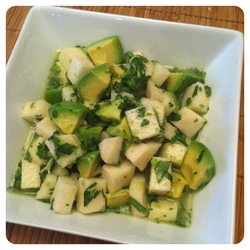 Jicama Avocado Salad 1/2 tsp Himalayan salt 1 Tbsp agave nectar juice of 1 lime 1 1/2 tsp extra virgin olive oil 1/2 avocado, ripe but firm, cut into chunks 1/2 medium jicama root, peeled and sliced into thin matchsticks (I cubed it instead) 2 Tbsp chopped fresh cilantro Mix all ingredients and let marinate in the refrigerator for 1 hour. Serve over 3 cups of salad greens. Serves 1. |
JulieFormer esthetician & LMT turned #GIRLBOSS, vegan food & fitness, travel, beauty, FUN!! Veg-curious friendly ☀️👙🌴✌🏻️ Archives
September 2015
Categories
All
|
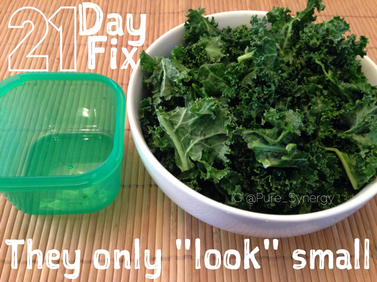









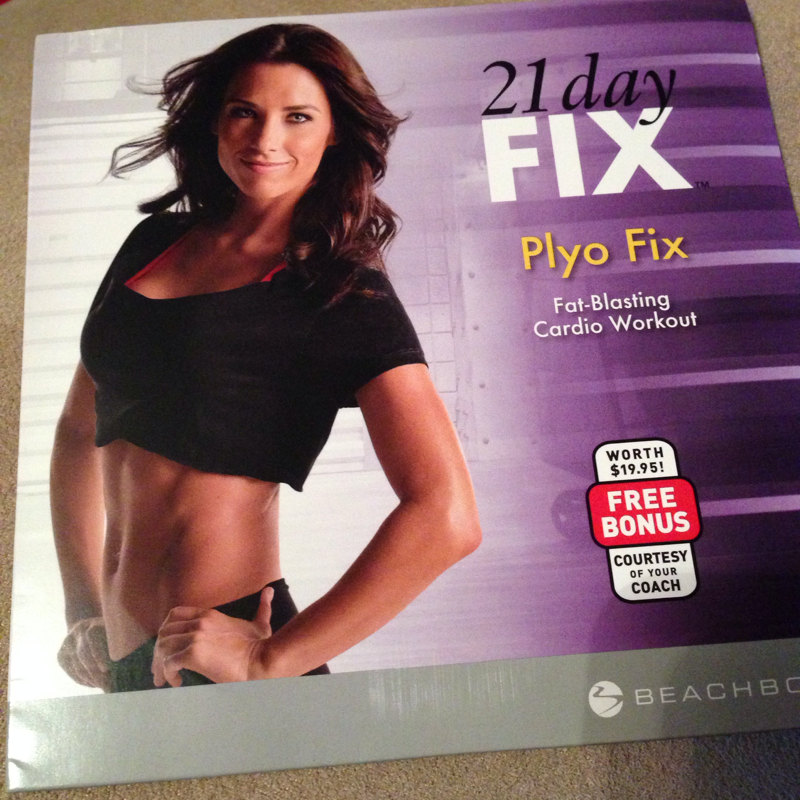



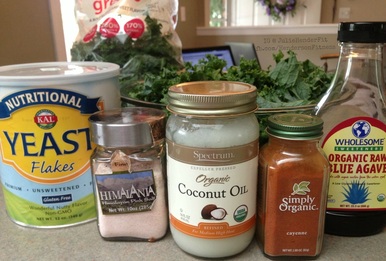












 RSS Feed
RSS Feed
